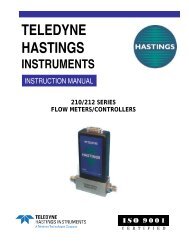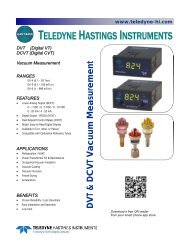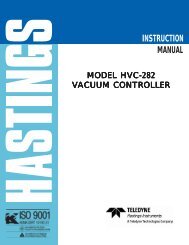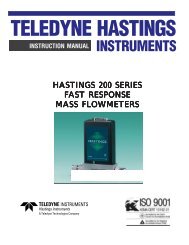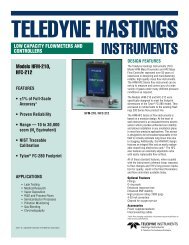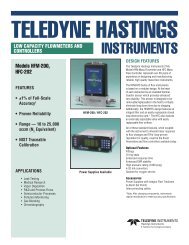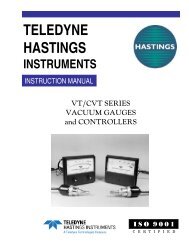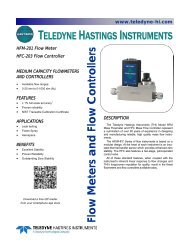HFM-301/305 HFC-303/307 - Teledyne Hastings Instruments
HFM-301/305 HFC-303/307 - Teledyne Hastings Instruments
HFM-301/305 HFC-303/307 - Teledyne Hastings Instruments
- No tags were found...
You also want an ePaper? Increase the reach of your titles
YUMPU automatically turns print PDFs into web optimized ePapers that Google loves.
2. Operation<br />
This section contains the necessary steps to assist in getting a new flow meter/controller into operation<br />
as quickly and easily as possible. Please read the following thoroughly before attempting to install the<br />
instrument.<br />
2.1. Receiving Inspection<br />
Carefully unpack the <strong>Hastings</strong> 300 Series instrument and any accessories that have also been ordered.<br />
Inspect for any obvious signs of damage to the shipment. Immediately advise the carrier who delivered<br />
the shipment if any damage is suspected. Check each component shipped with the packing list. Insure<br />
that all parts are present (i.e., flow meter, power supply, cables, etc.). Optional equipment or<br />
accessories will be listed separately on the packing list. There may also be one or more OPT-options on<br />
the packing list. These normally refer to special ranges or special gas calibrations. They may also refer<br />
to special helium leak tests, or high pressure tests. In most cases, these are not separate parts, but<br />
special options or modifications built into the flow meter.<br />
Quick Start<br />
1. Insure flow circuit mechanical connections are leak free.<br />
2. Insure electrical connections are correct (See label).<br />
3. Power up. (Allow 30 minutes to 1 hour warm-up for best accuracy.)<br />
4. Note the flow signal decays toward zero.<br />
5. Run ~20% flow (~ 1 VDC) through instrument for 5 minutes.<br />
6. Insure zero flow; wait 2 minutes, then zero the instrument.<br />
7. Instrument is ready for operation.<br />
2.2. Power Requirements<br />
The <strong>HFM</strong>-<strong>301</strong>/<strong>305</strong>/306 requires ±15 VDC @ 55 mA. The <strong>HFC</strong>-<strong>303</strong>/<strong>307</strong> requires ±15VDC @ 150 mA for<br />
proper operation. The supply voltage should be sufficiently regulated to no more than 50 mV ripple.<br />
The supply voltage can vary from 14.0 to 16.0 VDC. Surge suppressors are recommended to prevent<br />
power spikes reaching the instrument. The <strong>Hastings</strong> power supply described in Section Error! Reference<br />
source not found. satisfies these power requirements.<br />
2.3. Output Signal<br />
The standard output of the flow meter is a 0 - 5 VDC signal proportional to the flow rate. In the <strong>Hastings</strong><br />
power supply the output is routed to the display and is also available at the terminals on the rear panel.<br />
If a <strong>Hastings</strong> supply is not used, the output is available on pin 6 of the “D” connector. It is recommended<br />
that the load resistance be no less that 2 kΩ. If the optional 4 - 20 mA output is used, the load<br />
impedance must be less than 600 Ω.<br />
2.4. Mechanical Connections<br />
The flow meter may be mounted in any position as long as the direction of gas flow through the<br />
instrument follows the arrow marked on the bottom of the flow meter case label. The preferred<br />
orientation is with the inlet and outlet fittings in a horizontal plane. If operating with a dense gas (e.g.<br />
Manual: 152-082010 <strong>301</strong>-<strong>305</strong>-306_<strong>303</strong>-<strong>307</strong> Series Page 7 of 35



